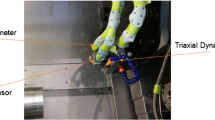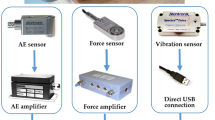Abstract
In a high speed milling operation the cutting tool acts as a backbone of machining process, which requires timely replacement to avoid loss of costly workpiece or machine downtime. To this aim, prognostics is applied for predicting tool wear and estimating its life span to replace the cutting tool before failure. However, the life span of cutting tools varies between minutes or hours, therefore time is critical for tool condition monitoring. Moreover, complex nature of manufacturing process requires models that can accurately predict tool degradation and provide confidence for decisions. In this context, a data-driven connectionist approach is proposed for tool condition monitoring application. In brief, an ensemble of Summation Wavelet-Extreme Learning Machine models is proposed with incremental learning scheme. The proposed approach is validated on cutting force measurements data from Computer Numerical Control machine. Results clearly show the significance of our proposition.
















Similar content being viewed by others

Notes
Note: classical definition of reliability “the ability of an item to perform a required function under given conditions for a given time interval” (NF EN 13306 2010) is not retained here. Actually, the acception used in this paper is according to application of machine learning approaches in PHM, that do not consider reliability as dependability measure (Bosnić and Kononenko 2009).
References
An, D., Kim, N. H., & Choi, J. H. (2015). Practical options for selecting data-driven or physics-based prognostics algorithms with reviews. Reliability Engineering & System Safety, 133, 223–236.
Benkedjouh, T., Medjaher, K., Zerhouni, N., & Rechak, S. (2013). Health assessment and life prediction of cutting tools based on support vector regression. Journal of Intelligent Manufacturing, 26(2), 213–223.
Bhat, A. U., Merchant, S., & Bhagwat, S. S. (2008). Prediction of melting point of organic compounds using extreme learning machines. Industrial and Engineering Chemistry Research, 47(3), 920–925.
Bosnić, Z., & Kononenko, I. (2009). An overview of advances in reliability estimation of individual predictions in machine learning. Intelligent Data Analysis, 13(2), 385–401.
Camci, F., & Chinnam, R. B. (2010). Health-state estimation and prognostics in machining processes. IEEE Transactions on Automation Science and Engineering, 7(3), 581–597.
Cojbasic, Z., Petkovic, D., Shamshirband, S., Tong, C. W., Ch, S., Jankovic, P., et al. (2015). Surfaceroughnessprediction by extreme learning machine constructed withabrasivewater jet. Precision Engineering. doi:10.1016/j.precisioneng.2015.06.013.
Das, S., Hall, R., Herzog, S., Harrison, G., & Bodkin, M. (2011). Essential steps in prognostic health management. In IEEE Conference on prognostics and health management. Denver, CO, USA.
Ding, F., & He, Z. (2011). Cutting tool wear monitoring for reliability analysis using proportional hazards model. The International Journal of Advanced Manufacturing Technology, 57(5–8), 565–574.
Echo state network. http://reservoir-computing.org/software.
NF EN 13306. (2010). Terminologie de la maintenance.
Feng, G., Huang, G. B., Lin, Q., & Gay, R. (2009). Error minimized extreme learning machine with growth of hidden nodes and incremental learning. IEEE Transactions on Neural Networks, 20(8), 1352–1357.
Gao, R., Wang, L., Teti, R., Dornfeld, D., Kumara, S., Mori, M., et al. (2015). Cloud-enabled prognosis for manufacturing. CIRP Annals-Manufacturing Technology. doi:10.1016/j.cirp.2015.05.011.
Ghasempoor, A., Moore, T., & Jeswiet, J. (1998). On-line wear estimation using neural networks. Proceedings of the Institution of Mechanical Engineers, Part B: Journal of Engineering Manufacture, 212(2), 105–112.
Grzenda, M., & Bustillo, A. (2013). The evolutionary development of roughness prediction models. Applied Soft Computing, 13(5), 2913–2922.
Haddadi, E., Shabghard, M. R., & Ettefagh, M. M. (2008). Effect of different tool edge conditions on wear detection by vibration spectrum analysis in turning operation. Journal of Applied Sciences, 8(21), 3879–3886.
Hu, C., Youn, B. D., Wang, P., & Yoon, J. T. (2012). Ensemble of data-driven prognostic algorithms for robust prediction of remaining useful life. Reliability Engineering & System Safety, 103, 120–135.
Huang, G. B., & Chen, L. (2007). Convex incremental extreme learning machine. Neurocomputing, 70(16), 3056–3062.
Huang, G. B., & Chen, L. (2008). Enhanced random search based incremental extreme learning machine. Neurocomputing, 71(16), 3460–3468.
Huang, G. B., Chen, L., & Siew, C. K. (2006). Universal approximation using incremental constructive feedforward networks with random hidden nodes. IEEE Transactions on Neural Networks, 17(4), 879–892.
Huang, G. B., Wang, D. H., & Lan, Y. (2011). Extreme learning machines: A survey. International Journal of Machine Learning and Cybernetics, 2(2), 107–122.
Huang, G. B., Zhu, Q. Y., & Siew, C. K. (2004). Extreme learning machine: A new learning scheme of feedforward neural networks. In International Joint conference on neural networks. Budapest, Hungary.
Huang, G. B., Zhu, Q. Y., & Siew, C. K. (2006). Extreme learning machine: Theory and applications. Neurocomputing, 70, 489–501.
Jaeger, H. (2001). The echo state approach to analyzing and training recurrent neural networks-with an erratum note. Bonn, Germany: German National Research Center for Information Technology GMD Technical Report, 148, 34.
Jaeger, H. (2002). Tutorial on training recurrent neural networks, covering BPPT, RTRL. GMD-Forschungszentrum Informationstechnik: EKF and the echo state network approach.
Jalab, H. A., & Ibrahim, R. W. (2011). New activation functions for complex-valued neural network. International Journal of the Physical Sciences, 6(7), 1766–1772.
Javed, K. (2014). A robust & reliable data-driven prognostics approach based on extreme learning machine and fuzzy clustering. Ph.D. thesis, Université de Franche-Comté.
Javed, K., Gouriveau, R., & Zerhouni, N. (2014). SW-ELM: A summation wavelet extreme learning machine algorithm with a priori parameter initialization. Neurocomputing, 123, 299–307.
Javed, K., Gouriveau, R., Zerhouni, N., & Nectoux, P. (2015). Enabling health monitoring approach based on vibration data for accurate prognostics. IEEE Transactions on Industrial Electronics, 62(1), 647–656.
Javed, K., Gouriveau, R., Zerhouni, N., Zemouri, R., & Li, X. (2012). Robust, reliable and applicable tool wear monitoring and prognostic: approach based on an improved-extreme learning machine. In IEEE conference on prognostics and health management. Denver, CO, USA.
Khosravi, A., Nahavandi, S., Creighton, D., & Atiya, A. (2011). Comprehensive review of neural network-based prediction intervals and new advances. IEEE Transactions on Neural Networks, 22(9), 1341–1356.
Li, X., Lim B. S., Zhou J. H., Huang, S., Phua S. J., & Shaw, K. C. (2009). Fuzzy neural network modeling for tool wear estimation in drymilling operation. In Annual conference of the prognostics and health management society. San Diego, CA, USA.
Liao, L. (2010). An adaptive modeling for robust prognostics on a reconfigurable platform. Ph.D. thesis, University of Cincinnati.
Massol, O., Li, X., Gouriveau, R., Zhou, J. H., & Gan, O. P. (2010). An exTS based neuro-fuzzy algorithm for prognostics and toolcondition monitoring. In 11th international conference on control automation robotics & vision ICARCV’10. Singapore, pp. 1329–1334.
Mathworks: Curve fitting toolbox. (2010). http://mathworks.com/help/toolbox/curvefit/smooth.html
Nguyen, D., & Widrow, B. (1990). Improving the learning speed of 2-layer neural networks by choosing initial values of the adaptive weights. In International joint conference on neural networks IJCNN. San Diego, CA, USA.
Oussar, Y., & Dreyfus, G. (2000). Initialization by selection for wavelet network training. Neurocomputing, 34(1–4), 131–143.
Pal, S., Heyns, P. S., Freyer, B. H., Theron, N. J., & Pal, S. K. (2011). Tool wear monitoring and selection of optimum cutting conditions with progressive tool wear effect and input uncertainties. Journal of Intelligent Manufacturing, 22(4), 491–504.
Peng, Y., Dong, M., & Zuo, M. J. (2010). Current status of machine prognostics in condition-based maintenance: A review. International Journal Advance Manufacturing Technology, 50, 297–313.
Petkovi, D., Danesh, A. S., Dadkhah, M., Misaghian, N., Shamshirband, S., & Pavlovi, N. D. (2016). Adaptive control algorithm of flexible robotic gripper by extreme learning machine. Robotics and Computer-Integrated Manufacturing, 37, 170–178. doi:10.1016/j.rcim.2015.09.006.
Rajesh, R., & Prakash, J. S. (2011). Extreme learning machines—A review and state-of-the-art. International Journal of Wisdom Based Computing, 1, 35–49.
Rao, C. R., & Mitra, S. K. (1971). Generalized inverse of matrices and its applications. New York: John Wiley and Sons.
Ren, L., Lv, W., & Jiang, S. (2015). Machine prognostics based on sparse representation model. Journal of Intelligent Manufacturing pp. 1–9. doi:10.1007/s10845-015-1107-8.
Rizal, M., Ghani, J. A., Nuawi, M. Z., & Haron, C. H. C. (2013). Online tool wear prediction system in the turning process using an adaptive neuro-fuzzy inference system. Applied Soft Computing, 13(4), 1960–1968.
Saikumar, S., & Shunmugam, M. (2012). Development of a feed rate adaption control system for high-speed rough and finish end-milling of hardened en24 steel. International Journal Advance Manufacturing Technology, 59(9–12), 869–884.
Shamshirband, S., Mohammadi, K., Chen, H. L., Samy, G. N., Petkovi, D., & Ma, C. (2015). Daily global solar radiation prediction from air temperatures using kernel extreme learning machine: A case study for Iran. Journal of Atmospheric and Solar-Terrestrial Physics, 134, 109–117. doi:10.1016/j.jastp.2015.09.014.
Sikorska, J. Z., Hodkiewicz, M., & Ma, L. (2011). Prognostic modelling options for remaining useful life estimation by industry. Journal of Mechanical Systems and Signal Processing, 26(5), 1803–1836.
Singh, R., & Balasundaram, S. (2007). Application of extreme learning machine method for time series analysis. International Journal of Intelligent Technology, 2(4), 256–262.
Wang, G., & Cui, Y. (2013). On line tool wear monitoring based on auto associative neural network. Journal of Intelligent Manufacturing, 24(6), 1085–1094.
Wu, Y., Hong, G., & Wong, W. (2015). Prognosis of the probability of failure in tool condition monitoring application—A time series based approach. The International Journal of Advanced Manufacturing Technology, 76(1–4), 513–521.
Zemouri, R., Gouriveau, R., & Zerhouni, N. (2010). Improving the prediction accuracy of recurrent neural network by a pid controller. International Journal of Systems Applications, Engineering & Development, 4(2), 19–34.
Zhai, L. Y., Er, M. J., Li, X., Gan, O. P., Phua, S. J., Huang, S., Zhou, J. H., Linn, S., & Torabi, A. J. (2010). Intelligent monitoring of surfaceintegrity and cutter degradation in high-speed milling processes. In Annual conference of the prognostics and health management society. Portland, Oregon, USA.
Zhao, G., Shen, Z., Miao, C., & Man, Z. (2009). On improving the conditioning of extreme learning machine: a linear case. In 7th International conference on information, communications and signal processing. ICICS 09. Piscataway, NJ, USA.
Zhou, J., Li, X., Gan, O. P., Han, S., & Ng, W. K. (2006). Genetic algorithms for feature subset selection in equipment fault diagnostics. Engineering Asset Management, 10, 1104–1113.
Zhou, J. H., Pang, C. K., Lewis, F., & Zhong, Z. W. (2009). Intelligent diagnosis and prognosis of tool wear using dominant feature identification. IEEE Transactions on Industrial Informatics, 5(4), 454–464.
Zhou, J. H., Pang, C. K., Zhong, Z. W., & Lewis, F. L. (2011). Tool wear monitoring using acoustic emissions by dominant-feature identification. IEEE Transactions on Instrumentation and Measurement, 60(2), 547–559.
Acknowledgments
This work was carried out within the Laboratory of Excellence ACTION funded by the French Government through the program “Investments for the future” managed by the National Agency for Research (ANR-11-LABX-01-01).
Author information
Authors and Affiliations
Corresponding author
Rights and permissions
About this article
Cite this article
Javed, K., Gouriveau, R., Li, X. et al. Tool wear monitoring and prognostics challenges: a comparison of connectionist methods toward an adaptive ensemble model. J Intell Manuf 29, 1873–1890 (2018). https://doi.org/10.1007/s10845-016-1221-2
Received:
Accepted:
Published:
Issue Date:
DOI: https://doi.org/10.1007/s10845-016-1221-2



